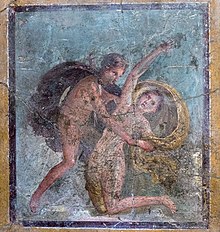| Daphne | |
|---|---|
The Laurel Nymph | |
| Member of the Naiads | |
 Antique fresco of Apollo and Daphne from Pompeii, 1st century | |
| Abode | Thessaly or Arcadia or Laconia |
| Genealogy | |
| Parents | (1) Peneus and Creusa (2) Ladon and Gaia (3) Ladon and Stymphalis (4) Amyclas |
| Siblings | (1) Menippe, Stilbe and Hypseus (2, 3) Metope |
Daphne (/ˈdæfni/; DAFF-nee; Greek: Δάφνη, Dáphnē, lit. 'laurel'),[1] a figure in Greek mythology, is a naiad, a variety of female nymph associated with fountains, wells, springs, streams, brooks and other bodies of freshwater.
There are several versions of the myth in which she appears, but the general narrative, found in Greco-Roman mythology, is that due to a curse made by the fierce wrath of the god Cupid, son of Venus, on the god Apollo (Phoebus), she became the unwilling object of the infatuation of Apollo, who chased her against her wishes. Just before being kissed by him, Daphne invoked her river god father, who transformed her into a laurel tree, thus foiling Apollo.
Thenceforth Apollo developed a special reverence for laurel. At the Pythian Games, which were held every four years in Delphi in honour of Apollo, a wreath of laurel gathered from the Vale of Tempe in Thessaly was given as a prize. Hence it later became customary to award prizes in the form of laurel wreaths to victorious generals, athletes, poets and musicians, worn as a chaplet on the head. The Poet Laureate is a well-known modern example of such a prize-winner, dating from the early Renaissance in Italy. According to Pausanias the reason for this was "simply and solely because the prevailing tradition has it that Apollo fell in love with the daughter of Ladon (Daphne)".[2] Most artistic depictions of the myth focus on the moment of Daphne's transformation.